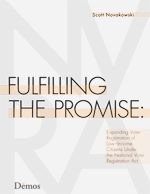Work by Demos and its partners suggests that millions of low-income Americans can be brought into the political process through proper implementation of an often-neglected provision of the National Voter Registration Act of 1993 (NVRA) that requires states to provide voter registration services to applicants and recipients of public assistance benefits. And the time is ripe to ensure that voter registration is provided at public assistance offices. Many public assistance programs are experiencing significant growth, with participation in the Supplemental Nutrition Assistance Program ("SNAP", formerly Food Stamps), one of the largest programs, now at an all-time high, having increased dramatically over the past year.
As the full effect of the economic downturn is felt throughout the country and increasing numbers of individuals turn to public assistance, the NVRA has never been more important for ensuring that low-income citizens have a voice in the democratic process.
TOP FACTS:
- Section 7 of the NVRA requires state public assistance agencies to provide voter registration services to applicants and clients. Such offices that must provide services include those administering benefits such as the Supplemental Nutrition Assistance Program, Temporary Assistance for Needy Families, Medicaid, State Children’s Health Insurance Program, and the Special Supplemental Nutrition Program for Women, Infants, and Children.
- Under the NVRA, voter registration services must be provided with each application, recertification or renewal, or change of address related to benefits.
- When implemented as intended, public agency voter registration can bring significant numbers of low-income citizens into the democratic process. The numbers of voter registration applications submitted to public assistance offices in Ohio, Missouri, North Carolina, Virginia, Illinois, and Tennessee sky-rocketed after successful attempts to improve compliance with Section 7 of the NVRA.
- Notwithstanding the dramatic numbers of voter registrations that result from effective implementation of Section 7 of the NVRA, the huge potential of public agency voter registration remains unrealized because of poor implementation and enforcement. Between initial implementation of the NVRA in 1995-1996 to the reporting period of 2007-2008, the number of voter registration applications from public assistance agencies dropped by 62 percent, from over 2.6 million to only 978,000.
- Millions of additional low-income Americans could be registered to vote with full implementation of Section 7 of the NVRA. Between 3.8 and 5.0 million voter registration applications from public assistance agencies could be expected nationwide over a two-year period – millions more than the 978,000 reported to the EAC for the 2007-2008 reporting period.
- State adoption of a discrete list of best practices will ensure compliance with the NVRA. (1) Ensure that each office has an adequate supply of voter registration applications and declination/preference forms. (2) Ensure that voter registration policies and procedures are in compliance with the requirements of the NVRA. (3) Ensure that voter registration policies and procedures are in a format that can be quickly referenced by front line agency employees. (4) Appoint a state-level NVRA Coordinator for each agency and Local Coordinators for each local office. (5) Ensure that all newly hired employees are trained on voter registration procedures and current employees receive refresher training at least annually. (6) Implement a comprehensive monitoring program including regular data collection and employee evaluation.

